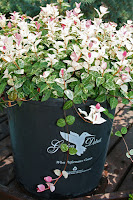by Geri Laufer
 |
| Basil flowers |
Botany
The main “goal” of
any plant is to flower, set seed in order to reproduce and then die.
Dead-heading is the process of picking off dead flower heads so that the plant
in question will keep blooming by developing more flower buds in its continued
attempts to set seed.
Annuals and
Horticultural Practice
Annual flowers go through
this process in one year. In order to prevent the early demise of an annual color
bed and keep plantings blooming at full strength throughout the season,
gardeners and landscapers routinely dead-head the plantings. This causes the
flowers to continue flowering and the herbs
producing more leaves for harvest. Bedded-out marigolds or pansies in a flower
bed, or an herb bed planted with annual basil come to mind.
Perennials
Although perennials
grow and increase in the garden for several years, they too can be profitably
dead-headed. For example, purple coneflower and black-eyed Susans regularly
bloom twice a season if the old flower heads are removed immediately after
their first flowering.
 |
| Dead Headed Seed Pods |
Woody Ornamental
Shrubs
Typically,
dead-heading is applied to herbaceous plants and not to woody ornamentals. In
the case of woodies, most people never think of applying this horticultural practice
to the flowering shrubs in their gardens or landscapes.
 |
| Seed Pods Blue Angel Althea |
Blue Angel Althea
One reliable shrub
that will continue to flower if the old seed capsules are removed is
Blue Angel Althea from
Garden Debut®. This shrub flowers prolifically in late
summer through early fall, and is covered with blue trumpets. But if the seed
capsules (that resemble tiny green acorn-squash) removed before they begin to
ripen, Blue Angel will continue to flower much later than normal, adding its
color and joy to the landscape.
Enjoy the delightful
color of Blue Angel Altheas twice as long by dead-heading old flowers and young
seed pods.
























